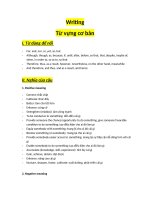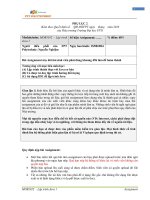Busm4699 a1a thesquad _Stage 1 (Assignment Task 1a): Team consultancy project proposal presentation 10%
Bạn đang xem bản rút gọn của tài liệu. Xem và tải ngay bản đầy đủ của tài liệu tại đây (1.8 MB, 27 trang )
Project SEM C 2022
Proposal
BUSM 4699 - Cross Cultural Management
Lecturer: Phil Smith
-Stage 1 -
A project of The Squad
AGENDA 1.. Cross-cultural communications discussion
2. Investigated topics' literature reviews
3. Consultant and organisation introduction
4. Sample questions kit
5. Timeline
6. References
WHAT IS CULTURE?
DEFINITION
Culture encompasses religion, food, what we wear, how we
wear it, our language, marriage, music and is different all over
the world (McKelvie and Pappas 2022)
DEFINITIONS
Cross-cutural management
Coexistence of different cultures in
the workplace. (Adler 1983)
Cross-cutural communication
Communication between people with
different culture. (Hurn & Tomalin 2013)
Cultural conflict in workplace
DEFINITION Different perspectives of power, resources, and compatibility can
cause cross-cultural conflict in the workplace. (Ruhl n.d.)
CONTEXT The majority of businesses now practice hiring a diverse crew.
PROS AND CONS
A diverse workforce ensures long-term Conflicts in the workplace are divisive
success in resolving cultural conflict. and reduce productivity.
EXAMPLES
Workplace Culture and Conflict
ETHNICITY RELIGION FEEDBACK COMMUNICATION
While some cultures Some acts may be Different cultures Depending on their
open/straightforward, against some have different work upbringing, people
others are reticent employees' religious feedback from diverse
and follow a hierarchy. beliefs. expectations. backgrounds interact
in different ways.
Communication
Misinterpretation
A wrong way of understanding or
failure of explaining the desired
message to others in communication
(Miura &Yamashita 2016)
Communication
Misinterpretation
Communicate by spoken language and words Communicate by body language, symbols,
deliver the message to listeners. (Doyle emotions, facial expressions, or gestures
2022)
(Anderson 2006)
Cross-cultural Barriers
Context cultural LOW CONTEXT CULTURAL
styles
Communication is straight forward,
explicit, simple, and clear.
=> Clear and direct message and
response (without afraid) (Meyer 2017)
Ex: North America and Western Europe
HIGH CONTEXT CULTURAL
Communication is indirect (implicit
message and contextual cues)
=> Indirect and implicit responses to
message senders (Meyer 2017)
Ex: Japan, China, Korea, Arab nations…
Lack of Trust
Trust is a power to build loyalty, close
relationships between employers and
employees, between coworkers.
Effective communication
Lack of Trust Difficult to build and maintain the close
relationships
Avoid to communicate, limit the
interactions
Ineffective communication
Investigated TOPIC 1
topics'
literature Communication inefficiency in
reviews remote working
TOPIC 2
Culture conflicts
1. Communication
inefficiency
Cultural barriers include
• the responsiveness of team members,
• the lack of engagement,
• the pace of decision-making,
• an unusual leadership style, unique
role expectations of team members,
• general behavioral presumptions, the
use of regional languages.
(RW3 2018)
Figure 1: Cultural challenges in remote working
(RW3 2018)
Sequential vs Synchronic
(Trompenaars Dimensions)
Explains how people in a certain
culture mark the passage of
time (Pirlog 2021)
SEQUENTIAL SYNCHRONIC
• Striving to complete one activity at a • Attempt to complete simultaneous
time and within a certain deadline activities in a limited amount of time.
(Pirlog 2021)
• Not timely and may alter the date and/or
• Exhibiting timeliness and time of a meeting at the final hour.
accountability in rigorously adhering
to work or company goals since time is • Planning is often a matter of
valuable (Balan & Vreja 2013). interpersonal interactions (Covas & Pirlog
2. Culture conflicts
Universalism vs Particularism
(rules vs relationships)
A policy for recognizing employee excellence within an
organization (vs seniority)
(Maniha 1975)
UNIVERSALISM PARTICULARISM
• Fundamental powers attempt to • They stress the peculiar interests of
establish acceptable principles of particular powers.
conduct
(Wallensteen
1984)
When confronted with a circumstance → they must decide "complying a general rule" vs
"supporting a colleague," they face a dilemma (Stouffer & Toby 1951)
Power Distance
Hofstede view Javidan & House view
Power gap is the degree to which people, The acceptance of power disparities
communities, or societies accept influences perspectives on how
disparities (e.g., inequalities in power, persons with varying amounts of
position, or income) as inescapable, authority ought to interact (Javidan
justified, or functional (Hofstede 1980) & House 2001)
High PD Low PD
Given the current emphasis on more Managers are more likely to undertake
empowering methods team-building activities, engage in
Ex: 360 degree feedback, participative training, and use independent work
goal setting, and autonomous work teams.
teams
(Daniels & Greguras
Consultants and Ms. Hoa (Deputy Project Manager)
organisation • Planning and Finance Manager with 20 years
introduction of experience managing ODA infrastructure
development projects.
• Being a part of PMU 85 since 2000.
Consultants and Project Management Unit 85 under the control
organisation of Ministry of Transport Vietnam
introduction
• work with foreign, international partners as
suppliers, contractors and consultants in our
projects financed by the World Bank.
• work with many expatriates and
international partners in their projects.
Figure 2: Dai Ngai Bridge is the recent
project of PMU 85
COMMUNICATION
Sample • What is the biggest barrier in
questions
kit communicating between
different culture in your
company?
• How can a manger connect
their employers together and
support them buiding trust?
Sample SEQUENTIAL & SYNCHRONIC
questions
kit • If the meeting lasts longer
than originally planned,
how do you solve this
situation? Will it affect the
meeting performance?
UNIVERSALISM & PARTICULARISM
Sample • Are there any exceptions to the
questions
kit rules established by the
company?
• How can you be flexible in
treatment between
particularism or universalism
cultures?









